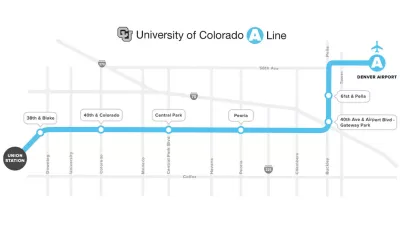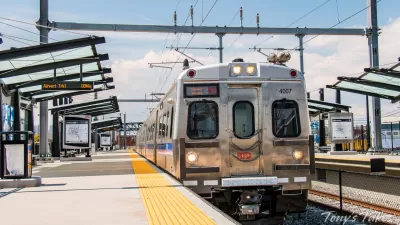The new University of Colorado A-Line service opened as scheduled. Free rides were offered Friday and Saturday to thousands of happy children of all ages to enjoy the 23-mile, 37-minute trip from Union Station to Denver International Airport.

The queue to catch the inaugural service of the A-Line went well into the street on Friday, tweeted Denver Post transportation reporter Monte Whaley. Revenue service begins Sunday. The line was described here last October which indicated it would open April 22.
Highly recommended: Watch the first of several Denver Post news videos [DPtv] on the new train line, featuring the ribbon-cutting (I spotted Gov. John Hickenlooper among the dignitaries). Carloads of beaming rail passengers enjoyed the ride, traveling at speeds up to 79 mph. Interviewed is "Brennan Walter, 23, [who] flew out from Manhattan, Kan., just to be on the first A-train run Friday," write Monte Whaley and John Aguilar for The Denver Post.
"I'm really interested and passionate about public transportation and Denver is way ahead of the curve in building a world class transit system region wide," states Walter. "This A-Line...is really a game changer in the way that it's been built and will be operated over the next 20 years by [public-]private partnership... It's a model for other new systems."
"It's the first electrified commuter rail line built in the U.S. in 'some decades'," he adds.
In looking at the Wikipedia list of commuter rail lines, I believe it's the first new electrified commuter rail (not to be confused with heavy rail like BART) line to be built in the U.S. since the South Shore interurban commuter rail line from South Bend, Indiana to Chicago opened in 1908. Existing lines, like LIRR, NJ Transit, Metro-North, Metra, SEPTA, and MARC were electrified after they were already operating as steam trains in the 19th century under their prior names as private railroads.
"Electrification in the U.S. reached its maximum of 3,100 miles (5,000 km) in the late 1930s," according to Wikipedia. "By 1973 it was down to 1,778 route miles (2,861 km) (Class I railroads) with the top 3 being: Penn Central 829 miles (1,334 km), Milwaukee Road 658 miles (1,059 km), Long Island Rail Road 121 miles (195 km)." I don't believe any of the original Milwaukee Road's electrified lines exist today.
Returning to April 22, not all were pleased with the A-Line. I refer not to riders but demonstrators.
"9to5 Colorado, which advocates for the working poor, protested at the ribbon-cutting ceremony, calling for a more equitable fare structure," write Whaley and Aguilar.
Another group — Colorado Fiscal Institute — also said RTD fares favor higher-income riders. They say RTD should provide a 50 percent discount off regular fares for riders who earn less than 150 percent of the federal poverty level. [See: CFI Report Shows How RTD Fares Can Be Fair]
While a trip to DIA from Union Station will cost an adult $9.00, local fare is a modest $2.60. [More on fares here. Also explained in Post video, "RTD: Everything you need to know about the train from downtown to DIA".]
Why named for a University?
Another first for the A-Line is that it may be the first rail line that came with naming rights, for a price. See DPtv: University of Colorado President Bruce Benson explains the decision to the Post's Molly Hughes to pay $5 million for the A-Line name for five years. [She asks all the right questions.]. Read her piece here. And no, the train doesn't service the university.
As posted earlier, "look for two new electrified commuter rail lines to be opening this year: Gold Line and the first segment of the Northwest Rail. A (third) line will open in 2018."
FULL STORY: A-train to Denver airport opens to public, hundreds wait to ride

Depopulation Patterns Get Weird
A recent ranking of “declining” cities heavily features some of the most expensive cities in the country — including New York City and a half-dozen in the San Francisco Bay Area.

Pennsylvania Mall Conversion Bill Passes House
If passed, the bill would promote the adaptive reuse of defunct commercial buildings.

California Exodus: Population Drops Below 39 Million
Never mind the 40 million that demographers predicted the Golden State would reach by 2018. The state's population dipped below 39 million to 38.965 million last July, according to Census data released in March, the lowest since 2015.

Google Maps Introduces New Transit, EV Features
It will now be easier to find electric car charging stations and transit options.

Ohio Lawmakers Propose Incentivizing Housing Production
A proposed bill would take a carrot approach to stimulating housing production through a grant program that would reward cities that implement pro-housing policies.

Chicago Awarded $2M Reconnecting Communities Grant
Community advocates say the city’s plan may not do enough to reverse the negative impacts of a major expressway.
City of Costa Mesa
Licking County
Barrett Planning Group LLC
HUD's Office of Policy Development and Research
Mpact Transit + Community
HUD's Office of Policy Development and Research
City of Universal City TX
ULI Northwest Arkansas
Town of Zionsville
Urban Design for Planners 1: Software Tools
This six-course series explores essential urban design concepts using open source software and equips planners with the tools they need to participate fully in the urban design process.
Planning for Universal Design
Learn the tools for implementing Universal Design in planning regulations.


























